Canning meat is easy. Yep, that’s where we’re starting today: what we’re about to do is pretty easy and everyone should be doing it. The freezer is great, but you do end up with degradation in taste and texture a lot faster than if you simply can your meat.
Today, we’ll work on beef. A cow in a jar, if you would. Keep in mind that you can do this with nearly any beef recipe too; beef stew is a long-time favorite and has been on everyone’s list of soups and stews to can forever. There’s a reason it’s so common in the grocery store and let me tell you; the markup that you’re paying is out of this world!
So, grab your canner, and let’s get to work!
Your Meat
For this example, I’ll be canning ground beef. You can use pickled beef but fresh beef is just better.
Brown your beef until it is fully cooked. Once cooked, drain it thoroughly. I do not recommend rinsing it, though you may choose to pat it dry. Why? The less fat on it, the better. Draining helps, but patting it also allows it to really get that last bit of grease off of it. The last thing that you want is for your canned meat to have trouble on the shelf and heavy fat content can cause issues long-term.
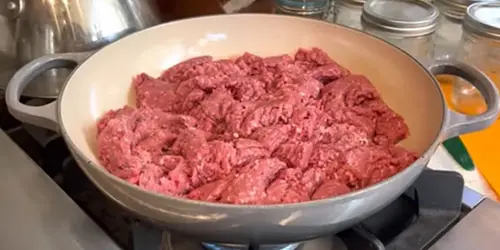
Our goal with this particular canning process is to try to find shelf-stable ground beef that can last up to five years. Of course, everyone eats their ground beef long before that. But just in case you want to stockpile your beef, keep in mind that you have half a decade with this method.
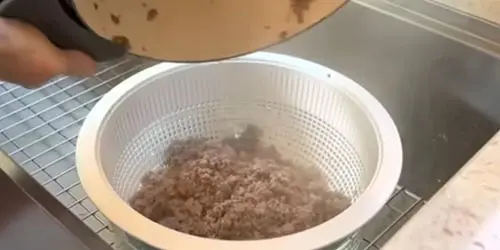
Fill your chosen canning jars approximately 1″ below the rim of the jar. Your average pint jar will hold about a pound of meat, give or take a little depending on how you break up the individual clumps in the pan. If desired, you can add a little seasoning to the meat at this point, too. This allows the seasoning to really settle into the meat versus using it in the pan where you may char it or leave some of it behind.
If you use your seasoning in the can, I recommend approximately 1 tsp of your chosen seasoning blend per pint of beef being stored. So, if you’re using a 2-quart jar, that’s 1 tablespoon and 1 teaspoon worth of seasoning. You may decide to go heavier or lighter depending on your exact spice blend.
Getting Ready
Once you’ve filled your jars with meat, it’s time to top them off. Boil water on your stove (I use an old teapot) and slowly top off your jars. If your seasoning floats, that’s just fine. It will eventually rehydrate and sink into the meat, essentially marinating it until it’s time to use the jar far in the future.
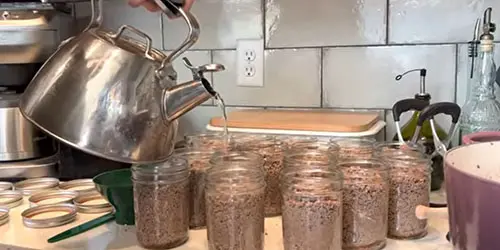
I generally recommend that you use vinegar (make sure it did not go bad) or another astringent (that is food-safe) to wipe down the rim of your jars at this point. If you don’t, you may lose a jar or two to mold here and there. It is still rather unlikely and if you need to avoid this step due to health concerns or allergies, the seal should still hold tight to your jar and you should still have safe food to eat.
However, you won’t have every jar sparkling clean when you pop the top off. So, if at all possible, wipe down the rims of your jars with a paper towel soaked with plain white kitchen vinegar and let it air dry briefly so as not to trap the vinegar scent in your jar.
It’s Canning Time!
Place your lids on your jars and tighten them down, by hand, as much as you can. If you have gripping problems (like your gallant author does), you may want to ask a family member to help you. You may also desire to use a handheld grip mat to help you hold on to the rather slippery glass jars.
Since I have no way to guess what your canner specifics are, I will give you a general sense of what ours is. Still, I strongly recommend that you read your canner’s recipe/guide book/how-to booklet and abide by those guidelines. While most canners are so safe that most of these instructions are interchangeable between brands and series, we don’t want anyone getting hurt. Therefore, our complete disclaimer is this: if you decide to use our model’s settings rather than researching your own, we cannot be held liable for what happens on your end. We only know what our machine does. Please use your machine’s directions.
Related: 10 Canning Recipes From The Amish
We place our rack into our canner and add about 3-4 inches of hot water (depending on the size of our jars; you never want your jars to be fully submerged). When our canner is full, we clamp it down and let it get up to steaming heat and around 15 pounds of pressure. We carefully regulate that pressure and temperature, then allow it to work for about an hour and a half. Again, please check your manual and do as it says, not necessarily as we do. Our canner is a newer model and may work differently than yours.
Once we reach this time mark, we turn off the heat and allow the canner to fully release all the pressure within it. When the gauge reaches 0 pounds, we remove the lid (with the lid used as a shield opening toward ourselves so the steam can’t rush out and hurt us).
At this point, we allow the canner and those gorgeous jars to cool and rest. Don’t be surprised if your jars are still bubbling inside. This is totally normal.
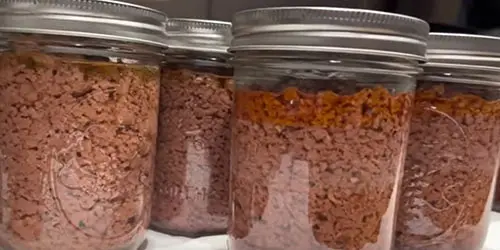
Remove your jars from the canner after about two hours of rest time. Place them on a kitchen towel and allow them to fully cool over the next 24 hours.
If desired, you can remove the screw rings from your cans. This does make inspection for popped lids a little easier, but I like the look of the screw rings on the lids and rarely remove them.
Final Thoughts
Keep in mind to inspect your jars as you put them on your shelves. If you see cracks, dents, or anything to suggest that a jar may not be fully sturdy, go ahead and throw the entire thing away. It is so much better than having a jar explode on you when you go to open it up. Don’t ask us how I know that; you all already know how I do!
These jars should remain viable food for up to five years after being sealed, so long as their seal remains. There may be a small amount of fat at the top of the jar, but that’s just fine. If the fat is visible all over the inside of the jar top to bottom, I recommend using those first.
Do you have a different method than I do? Or a recipe you’d like to share? Meet us down in the comments and happy canning!
You may also like:
The Canning Mistake That Could Make or Break Your Winter Supplies (Video)

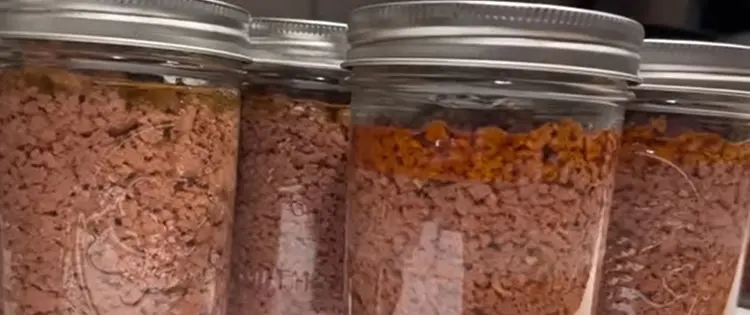









Can you do this with other meats as well?
Yes Harriet, you can do this with other meats. But follow canning directions explicitly for each type of meat. Take a look at this site. https://nchfp.uga.edu/#gsc.tab=0 Stay safe!
Can you use a steam counter or does it have to be pressurized?
Hi Sheree. Meats must be pressure canned. Check out this website. https://nchfp.uga.edu/#gsc.tab=0 Stay safe!